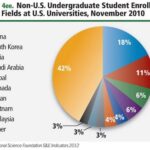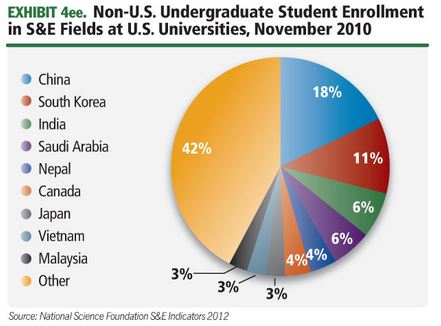India
2012 – Government Space Budgets Overview
Government space programs accounted for approximately $## billion in spending during 2012, representing ##% of the global space economy. Government investment in space grew by ##% in 2012, a rate lower than the average annual ##% growth rate between 2008 and 2012. The top-line figures, however, do not fully depict how some countries have significantly increased space spending while others have made cuts, as shown in Exhibit 2o below. Governments do not all operate under the same fiscal cycle, so international space spending numbers were derived…
2012 – Demographics
Considering the number of doctoral degrees earned in science and engineering, the European Union has the greatest proportion, followed by China and the United States. As with first university degrees, China has been rapidly increasing the number of doctoral science and engineering degrees granted since the early 2000s.
2012 – Demographics


Universities in the United States attract a large number of foreign students. The largest proportion of these students comes from China, followed by South Korea and India. Retaining these highly trained graduates is important, particularly at a time when global competition for this talent is increasing. . .
Beefing Up Military Satellite Communications
The U.S. Department of Defense launched its first Mobile User Objective System (MUOS) satellite in February 2012. With four more planned satellites, MUOS will provide global ultra-high-frequency (UHF) communications coverage, which has the advantage of being resistant to signal blockages by foliage, urban structures, or inclement weather.
Touring India Using GPS and 3D Maps
The integration of GPS receivers in smartphones has resulted in a surge of travel and navigation applications that can be used to enhance a travel experience. A startup company called My IndiEye Travel Companions has developed a GPS-enabled tourism application that can be used as an on-site tour guide at landmarks in India.
2012 – Building Space Infrastructure and Achieving Mission Objectives Within Reduced Budgets
Today, nations are under pressure to replace aging satellite infrastructure while continuing to deploy new satellite systems and achieve the related mission objectives within the constraints of tighter budgets. The situation is particularly challenging in the United States, where all government agen… Thank you for visiting The Space Report! The Authoritative Guide to Global Space…
2012 – IRNSS
The Indian Regional Navigation Satellite System (IRNSS) will include ## satellites providing coverage primarily for South Asia. Like the Japanese system, ## of the ## will be in non-equatorial GEO, while ## will be in traditional GEO. The first satellite is scheduled to be launched in early 2013. India also has a GPS augmentation system called GPS-Aided Geo Augmented Navigation (GAGAN, which is Hindi for “sky”), designed to improve air navigation in India. In September 2012, the second of three GAGAN payloads was put in orbit aboard the GSAT-10 satellite.
2012 – India Launch, Payload
In 2012, the Indian space program carried out ## launches, consistent with recent launch tempos for the Indian space program. India has worked to create and maintain an independent space launch capability and is poised to enhance its capabilities over the next several years with the development of a new cryogenic engine that will be used to power a new, larger final propulsion stage for India’s Geosynchronous Satellite Launch Vehicle (GSLV).
2012 – Other Countries, Launch, Human
Although Japan and India have both expressed interest in developing human spaceflight capabilities, neither has yet demonstrated strong commitment toward that goal. Japan is in early stage feasibility studies for its own crewed spacecraft, which would not be expected to fly before 2022. India identifies development of a human spaceflight program as an objective within its Five-Year Plan. However, specific details are sparse; India just states that it will focus on development of the technologies and systems necessary to support a human spaceflight program at some point.